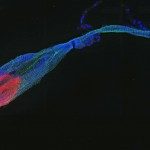Lien vers Pubmed [PMID] – 9765852
Res. Microbiol. 1997 Nov;148(8):673-81
Antimycobacterial drugs acting efficiently against Mycobacterium avium complex have in common low MICs and MBC/MIC ratios. The recently reported clinical efficacy of some of the newer drugs is also clearly linked to their pharmacokinetic properties such as higher serum level and/or intracellular concentrations and half-life. In the present investigation, comparative postantibiotic effects (PAEs) of amikacin, rifampin, sparfloxacin, clofazimine and clarithromycin were investigated. Bacteria were exposed to MIC, MIC x 4 and MIC x 8 concentrations of each drug for 2 h, the drug was removed by centrifugation and cells were thoroughly washed and resuspended in drug-free medium. Growth was compared to control organisms which underwent a similar treatment (but without drugs) and PAEs were assessed using the equation “T-C”, where T equals the time required for colony counts to increase by 1 log10 in test samples after antibiotic exposure and C equals the time for 1 log10 growth in control. Our results underlined two distinct patterns concerning PAE: pattern I included drugs for which PAE (in hours) was dose-dependent and varied (for MIC, MIC x 4 and MIC x 8 concentrations) for amikacin (10.3 +/- 1.7, 14.7 +/- 1.9 and 17.7 +/- 4.1), rifampin (28.0 +/- 7.6, 62.0 +/- 18.5 and 71.0 +/- 3.2) and clarithromycin (2.6 +/- 1.0, 15.0 +/- 4.0 and 22.0 +/- 4.0), whereas pattern II included drugs with a stable PAE, relatively independent of the drug concentrations: sparfloxacin (11.0 +/- 2.5, 12.3 +/- 6.4 and 13.0 +/- 2.1) and clofazimine (26.0 +/- 2.8, 28.8 +/- 2.5 and 27.3 +/- 1.3). These results may be useful for guidance in scheduling of drug administration in M. avium-infected AIDS patients overburdened with too many drugs given for various opportunistic infections.

